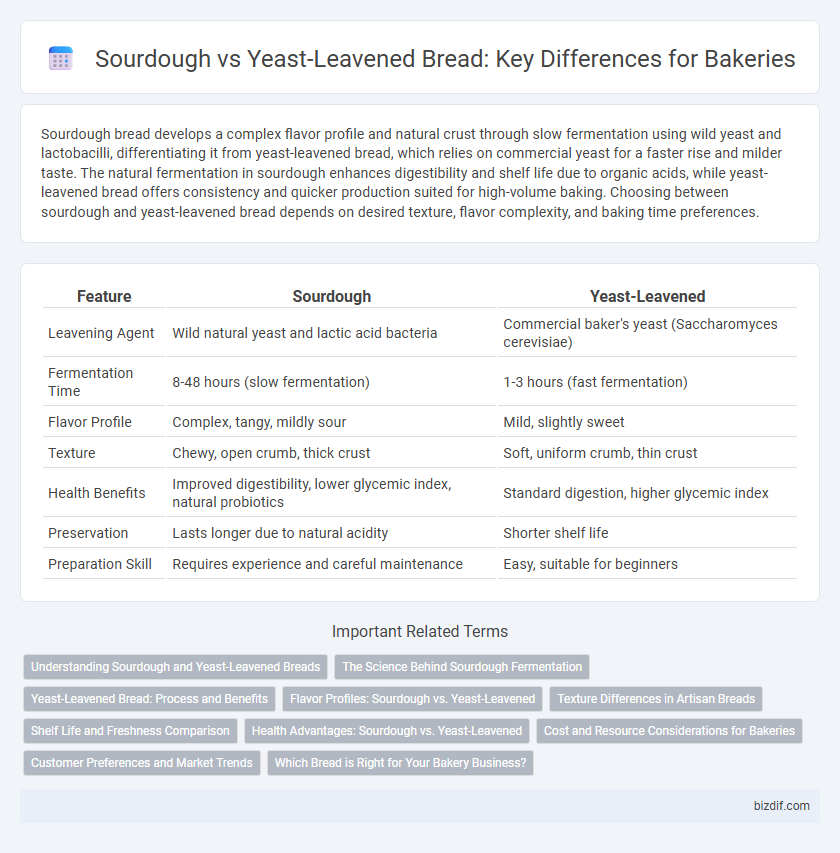Sourdough bread develops a complex flavor profile and natural crust through slow fermentation using wild yeast and lactobacilli, differentiating it from yeast-leavened bread, which relies on commercial yeast for a faster rise and milder taste. The natural fermentation in sourdough enhances digestibility and shelf life due to organic acids, while yeast-leavened bread offers consistency and quicker production suited for high-volume baking. Choosing between sourdough and yeast-leavened bread depends on desired texture, flavor complexity, and baking time preferences.
Table of Comparison
| Feature | Sourdough | Yeast-Leavened |
|---|---|---|
| Leavening Agent | Wild natural yeast and lactic acid bacteria | Commercial baker's yeast (Saccharomyces cerevisiae) |
| Fermentation Time | 8-48 hours (slow fermentation) | 1-3 hours (fast fermentation) |
| Flavor Profile | Complex, tangy, mildly sour | Mild, slightly sweet |
| Texture | Chewy, open crumb, thick crust | Soft, uniform crumb, thin crust |
| Health Benefits | Improved digestibility, lower glycemic index, natural probiotics | Standard digestion, higher glycemic index |
| Preservation | Lasts longer due to natural acidity | Shorter shelf life |
| Preparation Skill | Requires experience and careful maintenance | Easy, suitable for beginners |
Understanding Sourdough and Yeast-Leavened Breads
Sourdough bread relies on natural fermentation using wild yeast and lactic acid bacteria, which creates a tangy flavor and a chewy texture, while yeast-leavened bread uses commercial baker's yeast for faster rise and a milder taste. The longer fermentation in sourdough enhances digestibility and can improve nutritional value by reducing phytic acid content. Yeast-leavened breads are typically more consistent and easier to produce on a large scale, making them a staple in commercial baking.
The Science Behind Sourdough Fermentation
Sourdough fermentation relies on naturally occurring wild yeast and lactic acid bacteria, creating a symbiotic culture known as a starter that ferments dough more slowly than commercial yeast. This extended fermentation process breaks down gluten and starches, enhancing digestibility and producing complex flavors and organic acids that contribute to the bread's characteristic tang. The acidity generated by lactic acid bacteria also acts as a natural preservative, extending shelf life and improving nutritional profile compared to yeast-leavened bread.
Yeast-Leavened Bread: Process and Benefits
Yeast-leavened bread undergoes a rapid fermentation process where commercial yeast converts sugars into carbon dioxide, causing the dough to rise quickly, resulting in a soft and airy crumb texture. This method offers consistent results and shorter production times compared to sourdough, making it ideal for large-scale bakery operations. Rich in B vitamins and proteins, yeast-leavened bread provides a balanced nutritional profile while delivering a mild flavor that appeals to a broad range of consumers.
Flavor Profiles: Sourdough vs. Yeast-Leavened
Sourdough bread offers a complex flavor profile characterized by tangy, mildly acidic notes resulting from the natural fermentation of wild yeast and lactic acid bacteria. Yeast-leavened bread, by contrast, typically has a cleaner, milder taste with subtle sweetness due to rapid fermentation from commercial baker's yeast. The extended fermentation in sourdough enhances depth and texture, producing a crust with richer caramelization compared to the lighter crust of yeast-leavened varieties.
Texture Differences in Artisan Breads
Sourdough bread features a denser crumb and chewier texture due to natural fermentation by wild yeast and lactic acid bacteria, which develop complex gluten structures. Yeast-leavened breads typically have a lighter, airier crumb with a uniform texture, resulting from commercial yeast's rapid carbon dioxide production. Artisan bakers often prefer sourdough for its thick crust and tangy depth, while yeast-leavened loaves offer softness and consistency in texture.
Shelf Life and Freshness Comparison
Sourdough bread typically has a longer shelf life than yeast-leavened bread due to its natural fermentation process, which produces organic acids that inhibit mold growth. The tangy flavor and moist crumb of sourdough help maintain freshness for up to a week when stored properly, while yeast-leavened bread often stales faster, usually within two to three days. Both breads benefit from proper storage in a cool, dry environment to preserve texture and taste.
Health Advantages: Sourdough vs. Yeast-Leavened
Sourdough bread offers significant health advantages over yeast-leavened bread due to its natural fermentation process, which promotes the growth of beneficial bacteria and aids in digestion. The lactic acid bacteria in sourdough reduce phytic acid, enhancing mineral absorption such as iron, zinc, and magnesium. Additionally, sourdough often has a lower glycemic index, making it a better choice for blood sugar control compared to conventional yeast-leavened bread.
Cost and Resource Considerations for Bakeries
Sourdough bread requires longer fermentation times and careful maintenance of wild yeast cultures, leading to higher labor costs and more resource-intensive processes compared to yeast-leavened bread. Yeast-leavened breads utilize commercial yeast, which is cost-effective, easy to store, and speeds up production, reducing overhead expenses. Bakeries must weigh the premium price consumers might pay for artisanal sourdough against the efficiency and lower ingredient costs of yeast-leavened products.
Customer Preferences and Market Trends
Sourdough bread appeals to consumers seeking natural fermentation, enhanced flavor, and perceived health benefits due to its probiotic qualities, driving steady growth in artisan bakery markets. Yeast-leavened bread remains popular for its faster production time, consistent texture, and affordability, dominating mass-market bakery sales. Current market trends indicate a rising demand for sourdough varieties in urban and health-conscious segments, while traditional yeast breads maintain stronghold in convenience and value-driven consumer groups.
Which Bread is Right for Your Bakery Business?
Sourdough bread offers a unique tangy flavor and longer shelf life due to natural fermentation, appealing to artisanal bakery markets seeking premium products. Yeast-leavened bread provides faster production times and consistent texture, ideal for high-volume bakeries aiming for efficiency and uniformity. Choosing between sourdough and yeast-leavened bread depends on your bakery's target audience, production capacity, and desired product characteristics.
Sourdough vs Yeast-leavened Infographic

 bizdif.com
bizdif.com